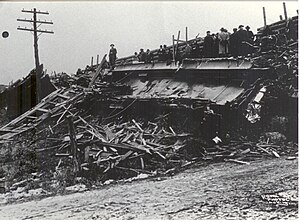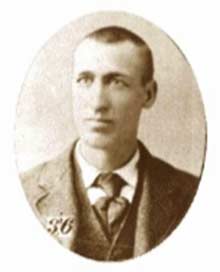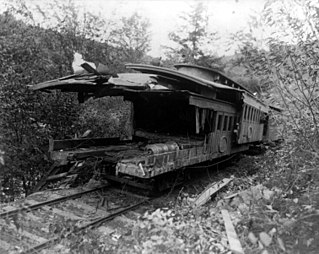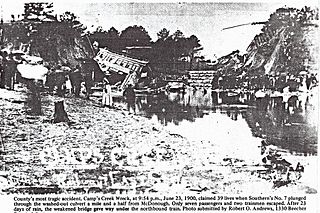Incident
A local train No.41, known as the Accommodation, departed Union Station in Louisville [5] at 4:35 pm, bound for Springfield. [1] It consisted of an engine pulling a baggage car, a combination smoker/colored car, and a first class car. It arrived at Brooks, 14 miles from Louisville at 5:12 pm, some six minutes late, and its conductor was told by the dispatcher to let the approaching Cincinnati-to-New Orleans express train, Flyer, pass at Shepherdsville unless he could make it to Bardstown Junction. [6] The Flyer had left Louisville at 4:53 pm, nearly two hours late; [1] it had nine steel cars and was intending to make up time on the run south. [6]
The local train's conductor decided to stop normally at Shepherdsville (rather than go straight into the siding) then confirm the Flyer's position before deciding whether to go back into the siding. Unfortunately when it arrived at the station at 5:24 the station operator had no news about the Flyer, so Conductor Campbell hurried to the depot for information. Meanwhile, the Flyer passed Brooks, giving four short whistle blasts to request right of way; this was granted, the signal being changed from red to green. The depot informed the Campbell that the Flyer was approaching fast so the local pulled forward in order to "back in" at the switch.
The engineer on the Flyer reported later that half a mile from Shepherdsville, "I blew four blasts for orders. I could see the signal only dimly, and it was green, our signal to proceed if we had seen it change from red to green. I did not see it change, I believed it had already changed from red to green, meaning for me to proceed". [6] As the local threw the switch to allow it to go back into the siding the signal automatically changed the signal to red. The Flyer's engineer immediately applied the emergency brakes but it was too late. It struck the rear of the wooden framed local at a speed of 25 mph. The engine continued to the entire length of the rear car, "shattering it completely" and continued through half the length of the smoker, though itself was not derailed. [6] The force of the collision drove the local forward a distance of 800 feet. [1]
A relief train arrived before 7 p.m. with 11 Louisville doctors and several surgeons, [6] but it was nearly midnight before the last of the mangled bodies was removed from the splintered wreckage; some were unrecognisable. [7]
Those killed or injured
The following people are known to have died in this train wreck. [6]
Father Eugene A. Bertello, Joshua Bethel Bowles, Hollis Bridges, Miss Josie Bridges, Mahlon H. Campbell, Carrie B. Cherry, Redford Columbus Cherry Sr., Redford Columbus Cherry Jr., Raymond Thomas Cravens, George C. Duke, Virginia Frances Duke, Lawrence C. Greenwell, Henry Z. Hardaway, Mattie E. Harmon, Joseph Raoul Losson Hurst, Louisa B. Hurst, Mrs. Catharine "Kate" A. Ice, W. C. Johnson, Silas "Sil" C. Lawrence, David Maraman, Emily Haycraft Mashburn, Miss Elizabeth McElroy, Amelia Miller, Lillian Miller, Mabel Brown Miller, W. McMakin Miller, Garnette McKay Moore, Lucas Moore, James Hartwell Morrison, Cora May Muir, George Shadburne Muir, Nathaniel Wickliffe Muir, Frank L. Nunn, Estella B. Nutt, Forrest L. Overall, Maggie Mae Overall, Bettie Phillips, David Phillips, John T. Phillips, Alice May Pulliam, Emory Samuels, Thomas Schaffer, Carrie May Simmons, Miss Mary Alethaire Simms, Thomas Spalding, J. W. Stansbury, Ben Talbott, James Thompson, N. H. Thompson.
These people have been identified as having sustained injuries as a result of the wreck. [6]
Henry Bowman, James Bradbury, Margaret Bradbury, Arthur Cahoe, James Carrico, Walter Carter, Benjamin Chapeze, Ed Clarkson, Miss Anna Cravens, Eliza M. Cravens, Frank Daugherty, Dr. D. S. Dodds, Mrs. George C. Duke, John Ford, Jeff D. Gregory, Judge Nat Halstead, Natalie Halstead, Edith Hatfield, Miss Lena Hatfield, Thomas W. Hoagland, Charles Jenkins, Charles Jessie, John Keyer, Howard Maraman, Ezekiel Masden, John McClure, George Moore, Claude Lee Nutt, Daniel Nutt, C. H. Perkins, Miss Ella Phillips, J. Frank Ratcliff, Annie Reed, Leonard Riney, Lee Roby, Harry Samuels, Susie Sheckles, C. William Shelton, Charles Showalter, John Showalter, Susan S. Simmons, J. E. Smith, Michael Smith (Bullitt County), Michael Smith (Louisville), Ethel Thornton, Roscoe Tucker, Elizabeth Ward, Henry Wilhite, Marvin Williams.













